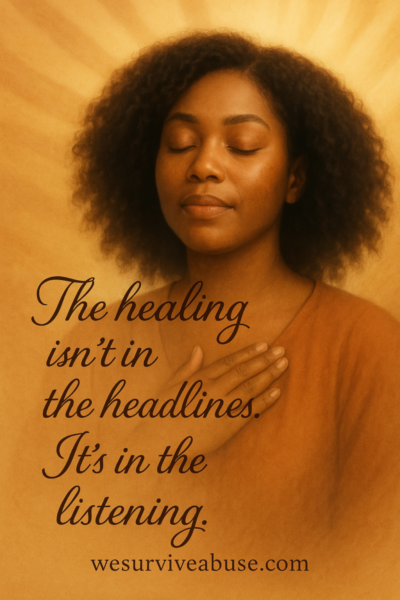There’s a manipulation tactic that keeps slipping into our public conversations—one that says:“Most people are abused by someone they know… so

There’s a manipulation tactic that keeps slipping into our public conversations—one that says:
“Most people are abused by someone they know… so we don’t really need to worry about stranger danger anymore.”
Let’s tell the truth:
That statement is weaponized to shut down real concerns.
To silence Survivors.
To shape the narrative in a way that benefits predators—whether they’re known or unknown.
Yes, it’s true that the majority of abuse comes from people the victim knows.
Family. Friends. Partners. Authority figures. That is a terrifying reality that still isn’t addressed enough.
But here’s what’s also true:
Stranger abuse still happens. Often. And it is still traumatic, still dangerous, still real.
You don’t erase one truth to validate another.
You don’t erase one truth to validate another.
There are Survivors who were followed.
Survivors who were drugged by someone they never met before.
Survivors attacked in public.
Survivors who didn’t know their rapist’s name—and never will.
Survivors harmed in moments when everyone told them they were “safe.”
And you know who benefits when we stop talking about stranger abuse?
Groomers who manipulate children online.
Predators who wait in bathrooms, clubs, buses, gyms, rideshares, and parking lots.
People who say “she’s lying—she doesn’t even know who did it.”
Systems, organizations, and groups that want to skip background checks.
Narratives that blame the victim for “being out late” or “talking to a stranger.”
Let’s be clear about this: Abuse by strangers is not a myth.
It’s just not the preferred narrative—because it doesn’t give people the illusion of control.
 People feel safer pretending that if they avoid strangers, they’ll be safe.
People feel safer pretending that if they avoid strangers, they’ll be safe.
But real safety means facing all the ways abuse shows up—familiar or not.
Real safety means telling the whole truth.
We don’t get to ignore one type of danger because another is more common. Unfortunately.
We don’t get to pit Survivors’ truths against one another.
We see you.
Whether you were hurt by someone you trusted—or someone you never met before. WE see you.
Your story is valid.
Your voice is real.
And you deserve protection, not statistical erasure.
📊 Prevalence of Sexual Violence
Frequency: Every 68 seconds, an American is sexually assaulted. RAINN+3RAINN+3RAINN+3
Lifetime Experience:
1 in 6 American women has been the victim of an attempted or completed rape.
Approximately 3% of American men—or 1 in 33—have experienced an attempted or completed rape. RAINN+1RAINN+1
Child Victims:
1 in 9 girls and 1 in 20 boys under the age of 18 experience sexual abuse or assault.
82% of all victims under 18 are female. RAINN+1RAINN+1
🚨 Reporting and Justice System Response
Underreporting: Only 310 out of every 1,000 sexual assaults are reported to police, meaning more than two-thirds go unreported. RAINN+2RAINN+2RAINN+2
Legal Consequences: Out of every 1,000 sexual assaults:
57 reports lead to an arrest.
11 cases are referred to prosecutors.
7 cases result in a felony conviction.
6 perpetrators will be incarcerated. RAINN+5RAINN+5RAINN+5
🎓 Sexual Violence on College Campuses
Prevalence Among Students:
13% of all students experience rape or sexual assault through physical force, violence, or incapacitation.
Among undergraduate students, 26.4% of females and 6.8% of males experience such incidents. RAINN
Reporting Rates: More than 90% of sexual assault victims on college campuses do not report the assault. National Sexual Violence Resource Center
🧠 Impact on Survivors
Mental Health: 81% of women and 35% of men report significant short-term or long-term impacts such as Post-Traumatic Stress Disorder (PTSD). National Sexual Violence Resource Center
Economic Cost: Each rape costs approximately $151,423, and annually, rape costs the U.S. more than any other crime ($127 billion). National Sexual Violence Resource Center
🔍 Additional Insights
Perpetrator Relationship:
In 8 out of 10 cases of rape, the victim knew the person who sexually assaulted them.
51.1% of female victims of rape reported being raped by an intimate partner, and 40.8% by an acquaintance. National Sexual Violence Resource Center+1National Sexual Violence Resource Center+1National Sexual Violence Resource Center
False Reporting: The prevalence of false reporting for sexual assault crimes is low—between 2% and 10%. National Sexual Violence Resource Center+1National Sexual Violence Resource Center+1
9 Reasons Why Making Laws Around Beliefs That Serve a Few While Harming Most is Dangerous
Male Predators Are Male: Why Language Matters for Survivor Justice
Love Doesn’t Mean Lying: I Can Respect You and Still Speak the Truth
How Changing Language Around Sex is Used to Undermine Women in Courtrooms